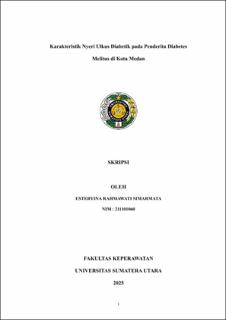| dc.description.abstract | Diabetes mellitus is one of the four most common non-communicable diseases (NCDs) worldwide. The longer a person suffers from diabetes mellitus, the higher the likelihood of experiencing chronic hyperglycemia, which eventually leads to diabetes complications, one of which is diabetic ulcers. This study aims to describe the characteristics of diabetic ulcer pain in diabetes mellitus patients in Medan. This study employs a quantitative research design with a descriptive approach. The sampling technique used is total sampling, with a total of 60 respondents. The instruments used in this study include a respondent characteristic questionnaire, the Numerical Rating Scale (NRS), and the PEDIS wound assessment. Data analysis was conducted using univariate analysis and frequency distribution. The results indicate that the majority of respondents experienced moderate pain intensity, accounting for 26 individuals (43.3%), with a duration of less than one hour in 23 individuals (38.3%). Factors that exacerbated pain included conditions such as sleeping, nighttime, and other factors in 21 respondents (35%). The results of the diabetic ulcer assessment were divided into several evaluation aspects: in the Perfusion aspect, the majority of respondents had a score of 0 (no peripheral artery disease) in 35 individuals (58.3%); in the Extent aspect, the majority of respondents had ulcers larger than 3 cm³ with a score of 3 in 32 individuals (53.3%); in the Depth aspect, most respondents scored 2, indicating deep ulcers involving subcutaneous tissue, fascia, muscles, or tendons, with 28 individuals (48.7%). In the Infection aspect, most respondents did not experience infection, with a score of 0 in 39 individuals (65%), and in the Sensation aspect, the majority had normal sensory sensation, with a score of 0 in 36 individuals (60%). This study concludes that most diabetic ulcer patients in Medan experience moderate pain, with characteristics influenced by factors such as age, gender, and health conditions. Comprehensive pain management and diabetic ulcer treatment need to be enhanced to prevent complications and the risk of amputation. | en_US |


